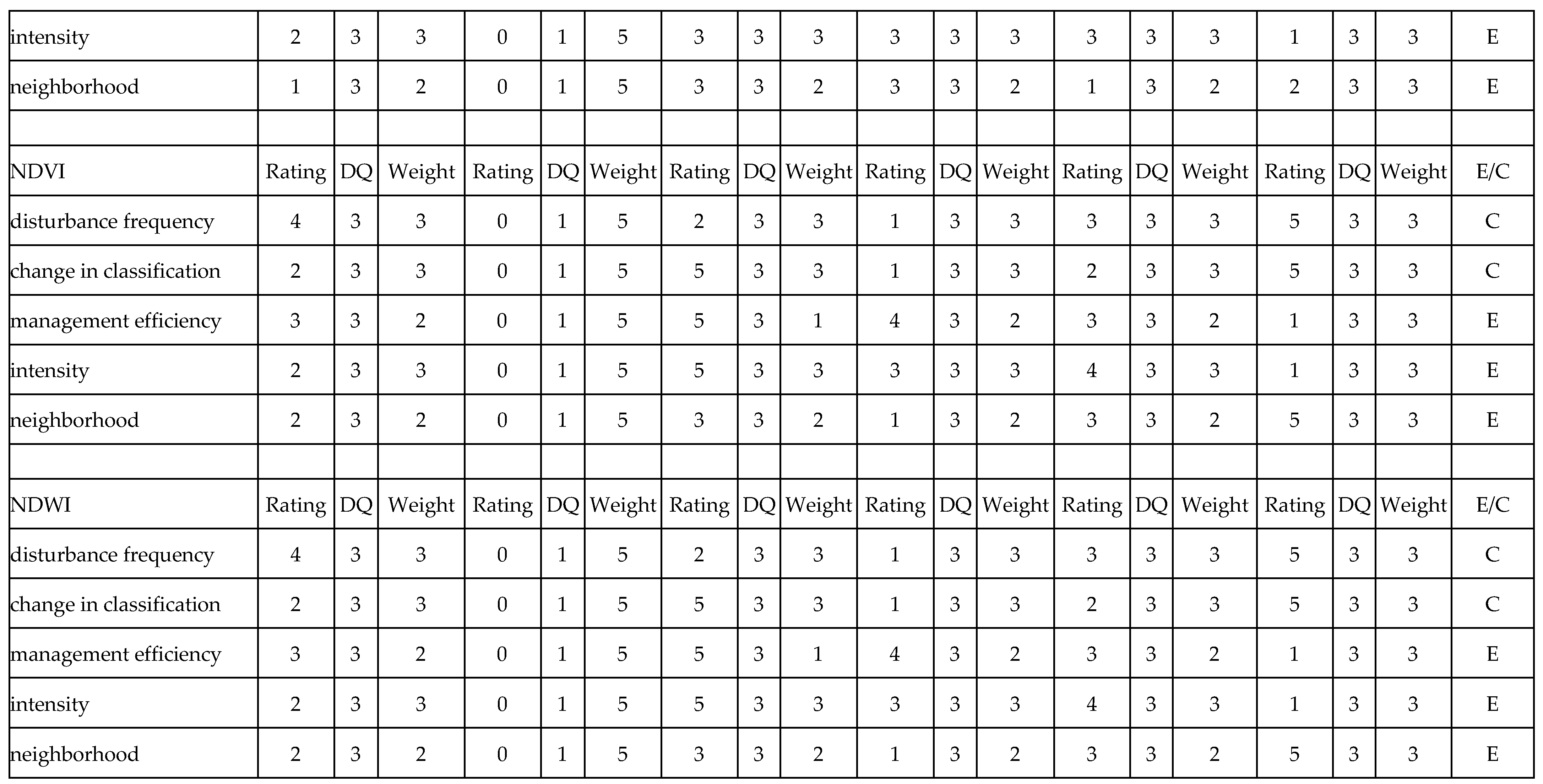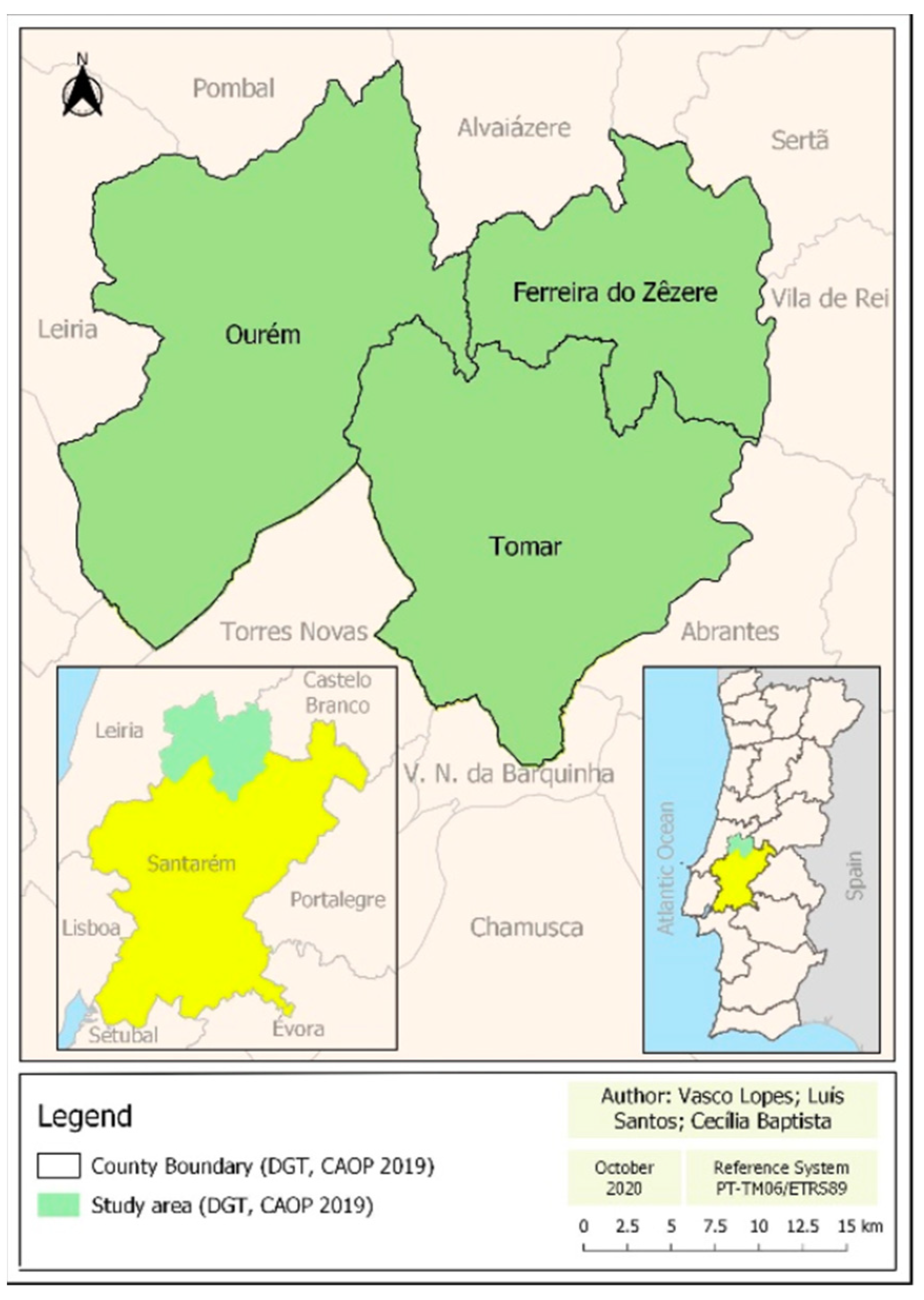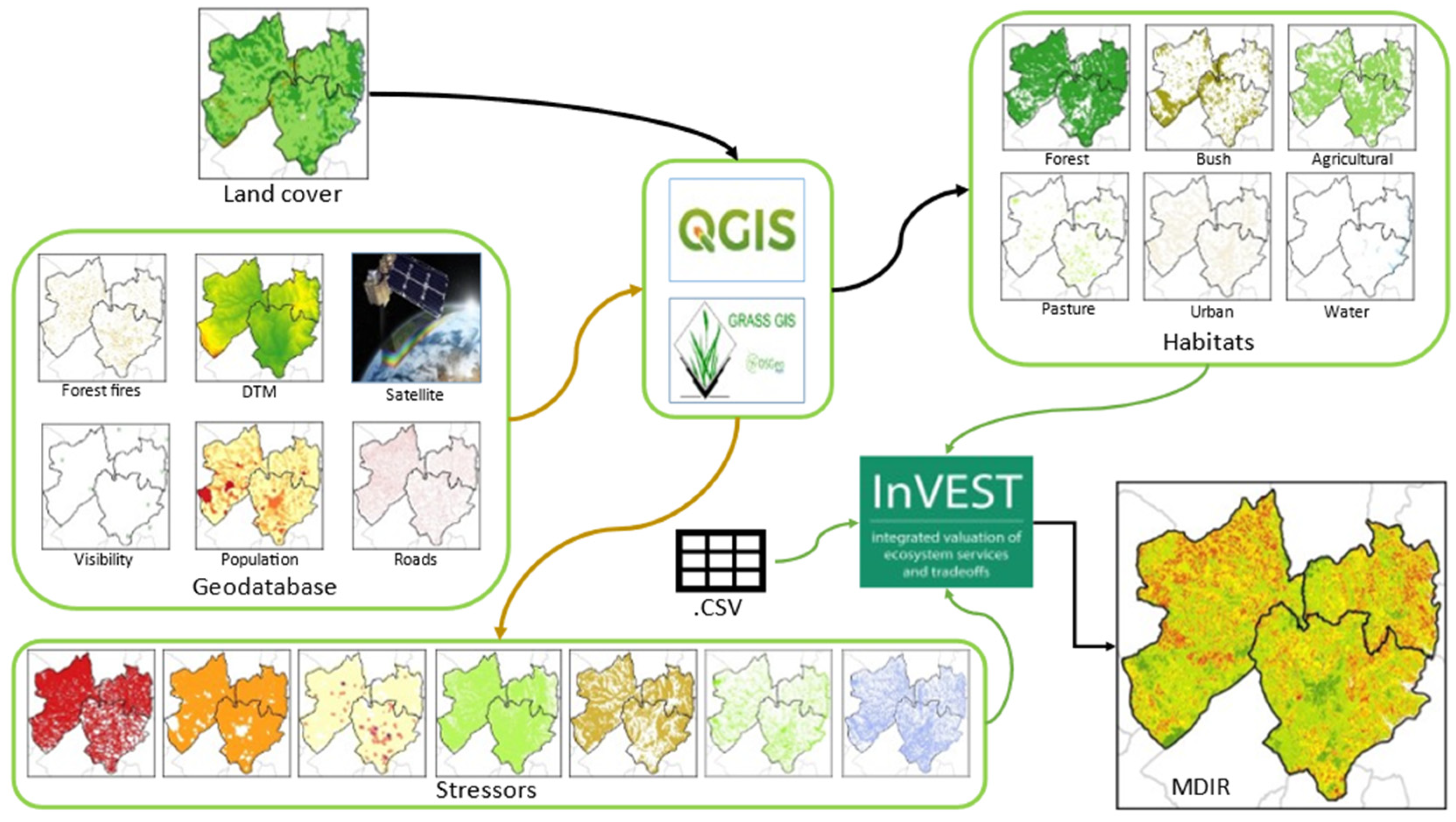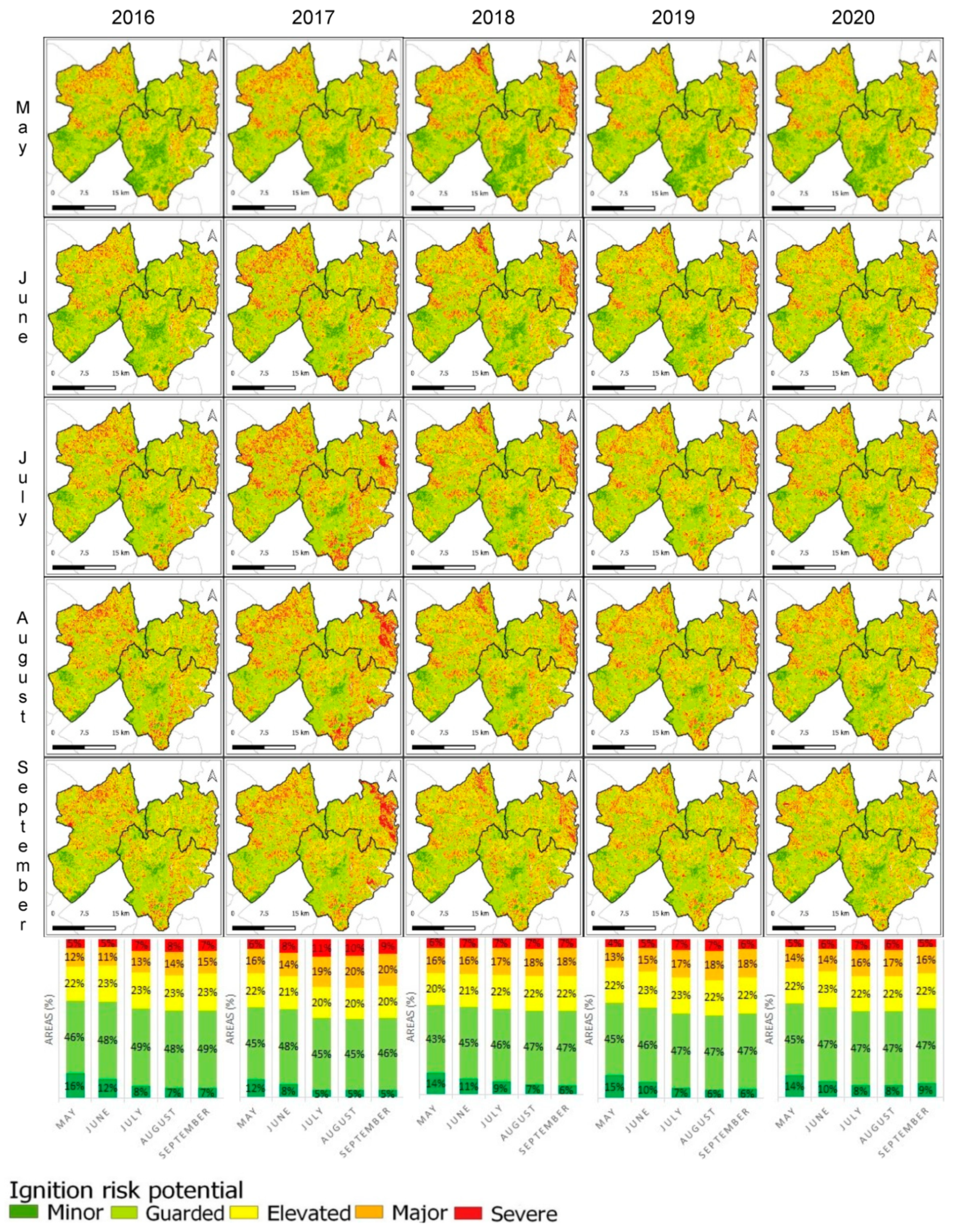MDIR Monthly Ignition Risk Maps, an Integrated Open-Source Strategy for Wildfire Prevention
Abstract
:1. Introduction
2. Materials and Methods
2.1. Study Area
2.2. Methods
- NAME—The name, that should be unique for each entry, and must match exactly those that appear in the “exposure_consequence_criteria.csv” file, never exceeding 8 characters.
- PATH—Corresponds to the path of the vector file of the input data. They can be absolute file paths.
- TYPE—Defines whether it corresponds to a habitat or a stressor.
- BUFFER STRESSOR—The desired buffer distance (in meters) to be used to expand the influence of a given stressor. It should be left blank for habitats, but should not be left blank for stressors or factors.
- Average growth: corresponds to the average growth rates of the various species that make up a type of soil occupation. According to the soil occupation variables considered, values between 1 and 5 were assigned, where the maximum value corresponds to the highest average growth rates and consequent resilience.
- Rotation rate: consists of changing the type of occupation, or the natural or anthropic soil characteristics of the various species that make up the class of soil occupation. Species that suffer a high turnover are less sensitive to fire-related stressors and therefore, are given a higher resilience value.
- Connectivity rate: corresponds to the level of connection between the types of land occupation with similar characteristics. In this way, greater connectivity implies greater resilience; therefore, they are given a greater weight.
- Natural recovery time: habitats consisting of species that reach maturity earlier show a faster recovery rate after a disturbance than those that take longer to reach maturity. Consequently, greater weight is attributed to soil occupations where the predominant species rapidly reach maturity.
- Frequency of disturbance: corresponds to the frequency at which the soil occupation type is disturbed by a stressor, i.e., whether the type of land occupation is disturbed or not, with the occurrence of an event. High rates of disturbance imply greater sensitivity, and therefore, they are given a higher weight.
- Change in classification: the change in structure corresponds to the percentage of structural density change in a type of soil occupation when exposed to a given stressor. Types of land occupation that lose a high percentage of area when exposed to a certain stressor are highly sensitive, while those that lose little area are less sensitive, and as such, the latter are assigned a lower weight.
- Management effectiveness: management can limit the negative impacts of stressors on the type of land occupation, so effective management reduces the likelihood of stress when compared to areas of land occupation where there is no management. As with other criteria, higher numbers represent higher exposure and, as such, less management effectiveness.
- Intensity of overlap: exposure depends not only on the overlap of the type of land occupation and stressors in space and time, but also on the cumulative effect of stressors.
- Neighborhood: exposure tends to increase when the types of land occupation in the vicinity are very similar; the opposite situation decreases exposure.
- Rating—This is a measure of the impact of a criterion on a given type of land occupation in relation to the general ecosystem. The classification is an integer between 1 and 5, assigned by taking the published bibliography into consideration. These numbers can be updated as better information becomes available. A rating score of 0 will tell the model to ignore these specific criteria.
- DQ—This column represents the quality of the score data provided in the Rating column. Here, the model gives the user the ability to reduce the weight of less reliable data sources or to define particularly well-studied criteria. A low DQ indicates the best data quality, while a high DQ indicates limited data quality. In this study, the criterion of an intermediate value (3) was used.
- Weight—The weight criterion gives the possibility to determine the most important criteria for the system, regardless of data quality. A low weight matches more important criteria, while a high weight indicates less important criteria.
- E/C—This column indicates whether the criteria given are being applied to exposure or the consequence of the chosen risk equation. By default, all criteria in the Sensitivity or Resilience categories will be assigned to Consequence (C) in risk equations, and all criteria in the Exposure category will be assigned to Exposure (E) in the risk equation.
3. Results and Discussion
4. Conclusions
Author Contributions
Funding
Informed Consent Statement
Data Availability Statement
Acknowledgments
Conflicts of Interest
Appendix A


Appendix B

References
- Couto, F.T.; Iakunin, M.; Salgado, R.; Pinto, P.; Viegas, T.; Pinty, J.P. Lightning modelling for the research of forest fire ignition in Portugal. Atmos. Res. 2020, 242, 104993. [Google Scholar] [CrossRef]
- Kountouris, Y. Human activity, daylight saving time and wildfire occurrence. Sci. Total Environ. 2020, 727, 138044. [Google Scholar] [CrossRef]
- Balch, J.K.; Bradley, B.A.; Abatzoglou, J.T.; Chelsea Nagy, R.; Fusco, E.J.; Mahood, A.L. Human-started wildfires expand the fire niche across the United States. Proc. Natl. Acad. Sci. USA 2017, 114, 2946–2951. [Google Scholar] [CrossRef] [Green Version]
- García-Llamas, P.; Suárez-Seoane, S.; Taboada, A.; Fernández-Manso, A.; Quintano, C.; Fernández-García, V.; Fernández-Guisuraga, J.M.; Marcos, E.; Calvo, L. Environmental drivers of fire severity in extreme fire events that affect Mediterranean pine forest ecosystems. For. Ecol. Manag. 2019, 433, 24–32. [Google Scholar] [CrossRef]
- Tessler, N.; Sapir, Y.; Wittenberg, L.; Greenbaum, N. Recovery of Mediterranean Vegetation after Recurrent Forest Fires: Insight from the 2010 Forest Fire on Mount Carmel, Israel. L. Degrad. Dev. 2016, 27, 1424–1431. [Google Scholar] [CrossRef]
- Oliveira, S.; Oehler, F.; San-Miguel-Ayanz, J.; Camia, A.; Pereira, J.M.C. Modeling spatial patterns of fire occurrence in Mediterranean Europe using Multiple Regression and Random Forest. For. Ecol. Manag. 2012, 275, 117–129. [Google Scholar] [CrossRef]
- Doerr, S.H.; Santín, C. Global trends in wildfire and its impacts: Perceptions versus realities in a changing world. Philos. Trans. R. Soc. B Biol. Sci. 2016, 371, 20150345. [Google Scholar] [CrossRef]
- Alló, M.; Loureiro, M.L. Assessing preferences for wildfire prevention policies in Spain. For. Policy Econ. 2020, 115, 102145. [Google Scholar] [CrossRef]
- Xu, W.; He, H.S.; Fraser, J.S.; Hawbaker, T.J.; Henne, P.D.; Duan, S.; Zhu, Z. Spatially explicit reconstruction of post-megafire forest recovery through landscape modeling. Environ. Model. Softw. 2020, 134, 104884. [Google Scholar] [CrossRef]
- Radeloff, V.C.; Helmers, D.P.; Anu Kramer, H.; Mockrin, M.H.; Alexandre, P.M.; Bar-Massada, A.; Butsic, V.; Hawbaker, T.J.; Martinuzzi, S.; Syphard, A.D.; et al. Rapid growth of the US wildland-urban interface raises wildfire risk. Proc. Natl. Acad. Sci. USA 2018, 115, 3314–3319. [Google Scholar] [CrossRef] [Green Version]
- Alcasena, F.J.; Salis, M.; Ager, A.A.; Castell, R.; Vega-García, C. Assessing wildland fire risk transmission to communities in northern spain. Forests 2017, 8, 30. [Google Scholar] [CrossRef] [Green Version]
- Górriz-Mifsud, E.; Burns, M.; Marini Govigli, V. Civil society engaged in wildfires: Mediterranean forest fire volunteer groupings. For. Policy Econ. 2019, 102, 119–129. [Google Scholar] [CrossRef]
- Parente, J.; Pereira, M.G. Structural fire risk: The case of Portugal. Sci. Total Environ. 2016, 573, 883–893. [Google Scholar] [CrossRef]
- Fernandes, P.M. Fire-smart management of forest landscapes in the Mediterranean basin under global change. Landsc. Urban Plan. 2013, 110, 175–182. [Google Scholar] [CrossRef] [Green Version]
- de Castro Galizia, L.F.; Rodrigues, M. Modeling the influence of eucalypt plantation on wildfire occurrence in the Brazilian savanna biome. Forests 2019, 10, 844. [Google Scholar] [CrossRef] [Green Version]
- Molina, J.R.; Lora, A.; Prades, C.; Rodríguez y Silva, F. Roadside vegetation planning and conservation: New approach to prevent and mitigate wildfires based on fire ignition potential. For. Ecol. Manag. 2019, 444, 163–173. [Google Scholar] [CrossRef]
- Quintano, C.; Fernández-Manso, A.; Stein, A.; Bijker, W. Estimation of area burned by forest fires in Mediterranean countries: A remote sensing data mining perspective. For. Ecol. Manag. 2011, 262, 1597–1607. [Google Scholar] [CrossRef]
- Taylor, S.W.; Woolford, D.G.; Dean, C.B.; Martell, D.L. Wildfire prediction to inform fire management: Statistical science challenges. Stat. Sci. 2013, 28, 586–615. [Google Scholar] [CrossRef] [Green Version]
- Jain, P.; Coogan, S.C.P.; Subramanian, S.G.; Crowley, M.; Taylor, S.; Flannigan, M.D. A review of machine learning applications in wildfire science and management. Environ. Rev. 2020, 28, 478–505. [Google Scholar] [CrossRef]
- Carmo, M.; Moreira, F.; Casimiro, P.; Vaz, P. Land use and topography influences on wildfire occurrence in northern Portugal. Landsc. Urban Plan. 2011, 100, 169–176. [Google Scholar] [CrossRef] [Green Version]
- Guo, F.; Su, Z.; Wang, G.; Sun, L.; Lin, F.; Liu, A. Wildfire ignition in the forests of southeast China: Identifying drivers and spatial distribution to predict wildfire likelihood. Appl. Geogr. 2016, 66, 12–21. [Google Scholar] [CrossRef]
- Catry, F.X.; Rego, F.C.; Bação, F.L.; Moreira, F. Modeling and mapping wildfire ignition risk in Portugal. Int. J. Wildl. Fire 2009, 18, 921–931. [Google Scholar] [CrossRef] [Green Version]
- Costafreda-Aumedes, S.; Comas, C.; Vega-Garcia, C. Human-caused fire occurrence modelling in perspective: A review. Int. J. Wildl. Fire 2017, 26, 983–998. [Google Scholar] [CrossRef]
- Vilà-Vilardell, L.; Keeton, W.S.; Thom, D.; Gyeltshen, C.; Tshering, K.; Gratzer, G. Climate change effects on wildfire hazards in the wildland-urban-interface—Blue pine forests of Bhutan. For. Ecol. Manag. 2020, 461, 117927. [Google Scholar] [CrossRef]
- D’Este, M.; Ganga, A.; Elia, M.; Lovreglio, R.; Giannico, V.; Spano, G.; Colangelo, G.; Lafortezza, R.; Sanesi, G. Modeling fire ignition probability and frequency using Hurdle models: A cross-regional study in Southern Europe. Ecol. Process. 2020, 9, 54. [Google Scholar] [CrossRef]
- Rodrigues, M.; Costafreda-Aumedes, S.; Comas, C.; Vega-García, C. Spatial stratification of wildfire drivers towards enhanced definition of large-fire regime zoning and fire seasons. Sci. Total Environ. 2019, 689, 634–644. [Google Scholar] [CrossRef]
- Chuvieco, E.; Congalton, R.G. Application of remote sensing and geographic information systems to forest fire hazard mapping. Remote Sens. Environ. 1989, 29, 147–159. [Google Scholar] [CrossRef]
- Jaiswal, R.K.; Mukherjee, S.; Raju, K.D.; Saxena, R. Forest fire risk zone mapping from satellite imagery and GIS. Int. J. Appl. Earth Obs. Geoinf. 2002, 4, 1–10. [Google Scholar] [CrossRef]
- Modugno, S.; Balzter, H.; Cole, B.; Borrelli, P. Mapping regional patterns of large forest fires in Wildland-Urban Interface areas in Europe. J. Environ. Manag. 2016, 172, 112–126. [Google Scholar] [CrossRef]
- Hernandez-Leal, P.A.; Arbelo, M.; Gonzalez-Calvo, A. Fire risk assessment using satellite data. Adv. Sp. Res. 2006, 37, 741–746. [Google Scholar] [CrossRef]
- Naderpour, M.; Rizeei, H.M.; Khakzad, N.; Pradhan, B. Forest fire induced Natech risk assessment: A survey of geospatial technologies. Reliab. Eng. Syst. Saf. 2019, 191, 106558. [Google Scholar] [CrossRef]
- Matin, M.A.; Chitale, V.S.; Murthy, M.S.R.; Uddin, K.; Bajracharya, B.; Pradhan, S. Understanding forest fire patterns and risk in Nepal using remote sensing, geographic information system and historical fire data. Int. J. Wildl. Fire 2017, 26, 276–286. [Google Scholar] [CrossRef] [Green Version]
- Phelps, N.; Woolford, D.G. Guidelines for effective evaluation and comparison of wildland fire occurrence prediction models. Int. J. Wildl. Fire 2021, 30, 225–240. [Google Scholar] [CrossRef]
- Moritz, M.A.; Batllori, E.; Bradstock, R.A.; Gill, A.M.; Handmer, J.; Hessburg, P.F.; Leonard, J.; McCaffrey, S.; Odion, D.C.; Schoennagel, T.; et al. Learning to coexist with wildfire. Nature 2014, 515, 58–66. [Google Scholar] [CrossRef] [PubMed]
- Gaglio, M.; Aschonitis, V.; Pieretti, L.; Santos, L.; Gissi, E.; Castaldelli, G.; Fano, E.A. Modelling past, present and future Ecosystem Services supply in a protected floodplain under land use and climate changes. Ecol. Modell. 2019, 403, 23–34. [Google Scholar] [CrossRef]
- Santos, L.; Lopes, V.; Baptista, C. Modernized Forest Fire Risk Assessment Model Based on the Case Study of three Portuguese Municipalities Frequently Affected by Forest Fires. Environ. Sci. Proc. 2020, 3, 30. [Google Scholar] [CrossRef]
- Nolè, L.; Pilogallo, A.; Saganeiti, L.; Bonifazi, A.; Santarsiero, V.; Santos, L.; Murgante, B. Land use change and habitat degradation: A case study from tomar (portugal). Smart Innov. Syst. Technol. 2021, 178 SIST, 1722–1731. [Google Scholar] [CrossRef]
- Rivas-Martínez, S.; Rivas-Sáenz, S.; Penas-Merino, A. Worldwide bioclimatic classification system. Glob. Geobot. 2011, 1, 1–638. [Google Scholar]
- Sari, F. Forest fire susceptibility mapping via multi-criteria decision analysis techniques for Mugla, Turkey: A comparative analysis of VIKOR and TOPSIS. For. Ecol. Manag. 2021, 480, 118644. [Google Scholar] [CrossRef]
- Çolak, E.; Sunar, F. Evaluation of forest fire risk in the Mediterranean Turkish forests: A case study of Menderes region, Izmir. Int. J. Disaster Risk Reduct. 2020, 45, 101479. [Google Scholar] [CrossRef]
- Oliveira, S.; Félix, F.; Nunes, A.; Lourenço, L.; Laneve, G.; Sebastián-López, A. Mapping wildfire vulnerability in Mediterranean Europe. Testing a stepwise approach for operational purposes. J. Environ. Manag. 2018, 206, 158–169. [Google Scholar] [CrossRef]
- Chergui, B.; Pleguezuelos, J.M.; Fahd, S.; Santos, X. Modelling functional response of reptiles to fire in two Mediterranean forest types. Sci. Total Environ. 2020, 732, 139205. [Google Scholar] [CrossRef]
- Navalho, I.; Alegria, C.; Quinta-Nova, L.; Fernandez, P. Integrated planning for landscape diversity enhancement, fire hazard mitigation and forest production regulation: A case study in central Portugal. Land Use Policy 2017, 61, 398–412. [Google Scholar] [CrossRef]
- Chergui, B.; Fahd, S.; Santos, X.; Pausas, J.G. Socioeconomic Factors Drive Fire-Regime Variability in the Mediterranean Basin. Ecosystems 2018, 21, 619–628. [Google Scholar] [CrossRef] [Green Version]
- Castillo Soto, M.E. The identification and assessment of areas at risk of forest fire using fuzzy methodology. Appl. Geogr. 2012, 35, 199–207. [Google Scholar] [CrossRef]
- Viegas, D.X.; Almeida, M.; Raposo, J.; Oliveira, R.; Viegas, C.X. Ignition of Mediterranean Fuel Beds by Several Types of Firebrands. Fire Technol. 2014, 50, 61–77. [Google Scholar] [CrossRef]
- Chrysafis, I.; Mallinis, G.; Tsakiri, M.; Patias, P. Evaluation of single-date and multi-seasonal spatial and spectral information of Sentinel-2 imagery to assess growing stock volume of a Mediterranean forest. Int. J. Appl. Earth Obs. Geoinf. 2019, 77, 1–14. [Google Scholar] [CrossRef]
- Fernández-Manso, A.; Fernández-Manso, O.; Quintano, C. SENTINEL-2A red-edge spectral indices suitability for discriminating burn severity. Int. J. Appl. Earth Obs. Geoinf. 2016, 50, 170–175. [Google Scholar] [CrossRef]
- Sevinc, V.; Kucuk, O.; Goltas, M. A Bayesian network model for prediction and analysis of possible forest fire causes. For. Ecol. Manag. 2020, 457, 117723. [Google Scholar] [CrossRef]
- Mohammadi, F.; Bavaghar, M.P.; Shabanian, N. Forest Fire Risk Zone Modeling Using Logistic Regression and GIS: An Iranian Case Study. Small-Scale For. 2014, 13, 117–125. [Google Scholar] [CrossRef]
- Bocken, N.M.P.; Geradts, T.H.J. Barriers and drivers to sustainable business model innovation: Organization design and dynamic capabilities. Long Range Plann. 2019, 53, 101950. [Google Scholar] [CrossRef]
- Tessler, N.; Wittenberg, L.; Greenbaum, N. Vegetation cover and species richness after recurrent forest fires in the Eastern Mediterranean ecosystem of Mount Carmel, Israel. Sci. Total Environ. 2016, 572, 1395–1402. [Google Scholar] [CrossRef] [PubMed]
- Peng, G.-X.; Li, J.; Chen, Y.-H.; Patah, N.A. A Forest Fire Risk Assessment Using ASTER Images in Peninsular Malaysia. J. China Univ. Min. Technol. 2007, 17, 232–237. [Google Scholar] [CrossRef]
- Michael, Y.; Helman, D.; Glickman, O.; Gabay, D.; Brenner, S.; Lensky, I.M. Forecasting fire risk with machine learning and dynamic information derived from satellite vegetation index time-series. Sci. Total Environ. 2021, 764, 142844. [Google Scholar] [CrossRef] [PubMed]
- Gao, B.C. NDWI—A normalized difference water index for remote sensing of vegetation liquid water from space. Remote Sens. Environ. 1996, 58, 257–266. [Google Scholar] [CrossRef]
- Gao, B.-C. Naval Research Laboratory, 4555 Overlook Ave. Remote Sens. Environ. 1996, 7212, 257–266. [Google Scholar] [CrossRef]








Publisher’s Note: MDPI stays neutral with regard to jurisdictional claims in published maps and institutional affiliations. |
© 2022 by the authors. Licensee MDPI, Basel, Switzerland. This article is an open access article distributed under the terms and conditions of the Creative Commons Attribution (CC BY) license (https://creativecommons.org/licenses/by/4.0/).
Share and Cite
Santos, L.; Lopes, V.; Baptista, C. MDIR Monthly Ignition Risk Maps, an Integrated Open-Source Strategy for Wildfire Prevention. Forests 2022, 13, 408. https://doi.org/10.3390/f13030408
Santos L, Lopes V, Baptista C. MDIR Monthly Ignition Risk Maps, an Integrated Open-Source Strategy for Wildfire Prevention. Forests. 2022; 13(3):408. https://doi.org/10.3390/f13030408
Chicago/Turabian StyleSantos, Luis, Vasco Lopes, and Cecília Baptista. 2022. "MDIR Monthly Ignition Risk Maps, an Integrated Open-Source Strategy for Wildfire Prevention" Forests 13, no. 3: 408. https://doi.org/10.3390/f13030408
APA StyleSantos, L., Lopes, V., & Baptista, C. (2022). MDIR Monthly Ignition Risk Maps, an Integrated Open-Source Strategy for Wildfire Prevention. Forests, 13(3), 408. https://doi.org/10.3390/f13030408






